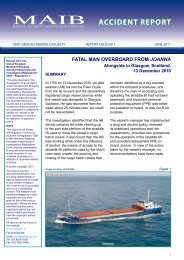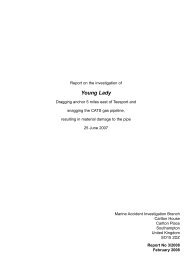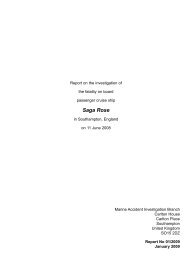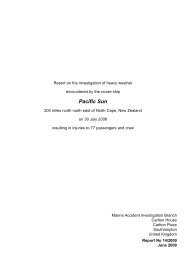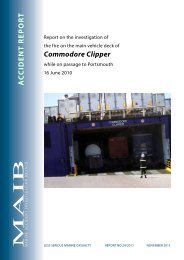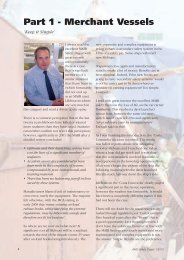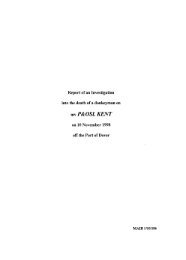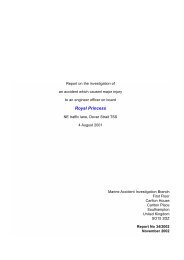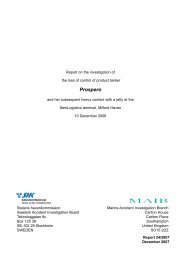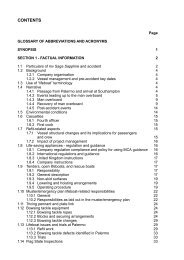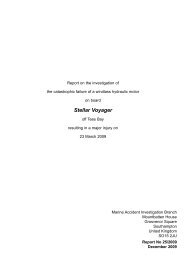Sichem Melbourne - Marine Accident Investigation Branch
Sichem Melbourne - Marine Accident Investigation Branch
Sichem Melbourne - Marine Accident Investigation Branch
Create successful ePaper yourself
Turn your PDF publications into a flip-book with our unique Google optimized e-Paper software.
14<br />
The Authority also actively promotes a forum for its pilots, the Pilots’ Operational<br />
Advisory Panel (POAPs), where pilots’ representatives and management meet to<br />
discuss issues with a view to improving common goals. Additionally, a hazard review<br />
panel, comprising managers and pilots, meets on a two monthly basis where they<br />
frequently discuss issues taken forward by Navigation Advisory Panels, which may be<br />
formed following incidents on the river.<br />
PLA owns, in conjunction with HR Wallingford 1 , a sophisticated two dimensional tidal<br />
model, which gives detailed tidal predictions at various points on the River Thames; the<br />
predictions for Coryton at the time of the accident are shown in Figure 6. Observed<br />
tidal values and surge differences from the predicted datum are monitored at various<br />
points throughout the river; Figure 7 gives this information for Coryton, 2 hours before<br />
and after the incident. This indicates that the heights of tide, and therefore stream<br />
velocity at the time of the accident, to be very close to the predicted values.<br />
1.7.1 Pilotage<br />
The London Pilotage District stretches from Putney Bridge in the west to the Sunk pilot<br />
station in the east. At the time of the accident the PLA employed 90 pilots of varying<br />
proficiency and ability, including:<br />
• Twelve berthing pilots – specialist senior sea pilots retained for their experience<br />
of safely berthing and unberthing tankers of > 11,000GT or 160m in length.<br />
• Sixty six sea pilots, ranging from class 4 to class 1 pilots, responsible for<br />
navigating vessels safely from the outer pilot stations to inland as far as<br />
Crayfordness.<br />
• Twelve river pilots who specialise in the stretch of the river between Gravesend<br />
and London Bridge, three of whom are bridge pilots specialising in under bridge<br />
clearance from London Bridge to Putney Bridge.<br />
Compulsory pilotage is required for, among others: all specified vessels (vessels<br />
carrying explosives, flammables etc); vessels > 50m carrying marine pollutant in bulk,<br />
and vessels with an operating draught of 5m or more.<br />
PLA pilots work a 9 days “on”, 6 days “off” rota, with pilots moving to the bottom of the<br />
“turns list” after completing a “trip” or act of pilotage. This normally allowed no fewer<br />
than 8 hours off duty after an 8 hour “trip”, or 12 hours off after a 12 hour “trip” etc. The<br />
system allowed the Authority to service an average of 26 sea pilotage acts and 5 river<br />
acts daily.<br />
After being notified of a pending “trip,” pilots had the option of either attending the pilots’<br />
“ready room”, at PLA offices, to make preparations for their trip or, where a pilot had<br />
external internet access to POLARIS (the Port’s Ship Information System), they could<br />
join a ship directly from home. A fundamental part of a pilot’s preparation for a “trip”<br />
is the compiling of a Passage Plan. PLA had a house style Master/Pilot Information<br />
Exchange and Passage Plan (Annex 4), but did not insist on its use by their pilots;<br />
this plan had a section dedicated to manoeuvring and mooring. PLA allowed pilots to<br />
1 HR Wallingford: Independent research and consultancy experts in civil engineering and environmental<br />
hydraulics; formerly the Hydraulics Research Station of the UK Government.



